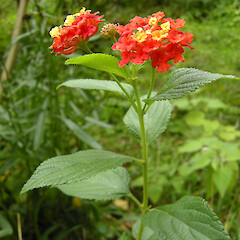Lantana camara var. aculeata
Common name
lantana
Family
Verbenaceae
Flora category
Vascular – Exotic
Structural class
Trees & Shrubs - Dicotyledons
NVS code
The National Vegetation Survey (NVS) Databank is a physical archive and electronic databank containing records of over 94,000 vegetation survey plots - including data from over 19,000 permanent plots. NVS maintains a standard set of species code abbreviations that correspond to standard scientific plant names from the Ngä Tipu o Aotearoa - New Zealand Plants database.
LANCAM
Conservation status
Not applicable
Detailed description
Aromatic shrub; stems upright to spreading, or almost scrambling to about 2m high, usu. with recurved prickles. Petioles to 2cm long. Lamina 3~13 x 1.5~7cm, ovate or oblong-ovate, crenate or crenate-serrate, densely hispidulous or scabrid above, the hairs usually dense but soft below; glandular scales minute; base cuneate to subcordate; apex acute to short-acuminate. Infl. corymbose; flowers fragrant. Peduncles 3~10cm long, moderately slender; bracts (1~3)/4 length of corolla tube, linear-lanceolate, densely hairy but eglandular. Calyx 1.5~2.5mm long, ciliate. Corolla densely puberulent outside; tube around 1cm long, narrow-cylindric; limb 6~10mm diam., when fresh, rather flat except for generally recurved lobes, usu. initially cream or pale yellow, changing to pink to rose, rarely deep yellow or orange. Drupe approx. 5mm diam., globular, black or blue-black. (- Webb et. al., 1988)
Similar taxa
The pink and yellow variety is the bad one (Ewen Cameron pers. comm.) IN NZ the dominant weedy variety seems to be the pink and yellow form. However in some areas the orange and yellow form is proving to be weedy as well. Especially on Great Barrier Island where there are several infestations of this form. (Mike Harre Auckland Regional Council). In Sydney, pink/yellow hugs the coastline. Yellow/orange/red hugs the western areas at the base of the Blue Mountains. I suspect this is related to climate (lower rainfall and higher evaporation) though not proven. (Michael Clarke, Sydney)
Flower colours
Cream, Yellow
Etymology
aculeata: From the Latin aculeus ‘stinger’, aculeatus means ‘barbed’, ‘stinging’ or ‘prickly’
Poisonous plant:
The blue black fruit have poisoned children and stock.














